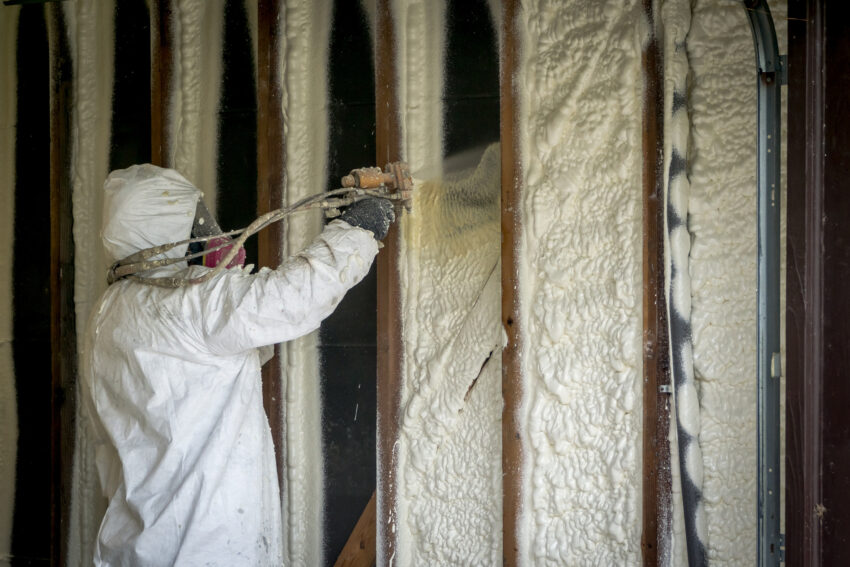The average cost of spray foam insulation is $6,000. People typically spend between $3,000 and $10,000 to insulate their homes. We’re diving into everything you need to know about spray foam installation, including costs and pricing, methods and types of installation, and money-saving tips.
What Is Spray Foam Insulation?

Spray foam insulation is made from various materials, and some types cost more than others. The most popular type is made from polyurethane and isocyanate, which, when combined together, expand and harden to cover all of the nooks and crannies around the application area.
Types of Spray Foam
With a variety of types of insulation technology, it can be hard to distinguish what’s best for your home. Here are a few common types, costs, and best uses:
| Spray foam insulation type | Cost per board foot | Best for |
| Polyurethane | $0.45 to $1.50 | Attics, basements, shops, and home exteriors |
| Water-based | $0.50 to $2.50 | Eco-friendly applications in attics, walls, crawl spaces, and ceilings |
| Soybean | $1.50 to $3.00 | Attics, basements, and walls |
| Vegetable oil | $1.50 to $3.00 | Eco-friendly applications in walls, roofs, floors, and attics |
Factors Used to Calculate Spray Foam Insulation Cost

Square Footage to be Insulated
It goes without saying that the larger the area you need to insulate, the more it will cost. You can use the figures below to determine the cost per inch of thickness for open-cell and closed-cell spray foam insulation.
| Size of area (square feet) | Open-cell insulation cost* | Closed-cell insulation cost* |
| 500 | $225 to $375 | $500 to $800 |
| 1,000 | $450 to $750 | $1,000 to $1,600 |
| 1,500 | $675 to $1,125 | $1,500 to $2,400 |
| 2,000 | $900 to $1,500 | $2,000 to $3,200 |
*per inch of thickness
Thickness of the Insulation Layer
Since spray foam insulation is measured in board feet, an inch of thickness is the most common way to calculate. However, it’s worth noting that most applications require multiple inches for optimal insulating value.
The R-value of open-cell insulation is 3.5 to 3.6 per inch, and for closed-cell insulation, the R-value is 6 to 7 per inch. Determine the amount of R-value you want, then calculate the thickness you need for the insulation you use.
Geographic Location and Climate Considerations
Depending on your climate type, you may need more insulating power for your buildings. Whether you’re protecting your home from heat or cold, insulation will help lower energy costs.
Here are common R-value recommendations for various parts of the home.
- Exterior walls- R-13 to R-23
- Attics- R-30 to R-49
- Ceilings- R-30 to R-49
- Floors- R-13 to R-30
Labor Rates in Your Region
Labor costs for many types of home improvement projects vary depending on what region you live in. In more rural areas, labor is usually less expensive than in urban areas. Generally, the higher the cost of living where you’re located, the more you will pay for labor.
Additional Costs and Considerations

Surface Preparation Needs
You need a clean surface for spray foam insulation to adhere to. In old houses, this means removing old insulation, which can be contaminated with anything from rodent feces to mold and allergens. Removing old insulation costs about $1 to $2 per square foot.
Equipment Rentals (if DIY)
If you’re DIYing spray foam installation, you must rent the necessary equipment. It can be a difficult job for green DIYers, but if you’re feeling up to it, be sure to learn as much as you can before you attempt it.
Renting the equipment for spray foam installation costs about $500 to $800 per day. You’ll also need safety equipment and coveralls, which add to your total cost.
Potential Building Code Compliance Issues
Following building codes is important to maintain the resale value of your property. Building codes vary from region to region, and they are updated frequently.
R-value minimums are among the most critical building code compliance requirements related to spray foam insulation. To meet building codes, you may also need to use vapor barriers and fire-rated materials, which will add to the cost of your project.
Disposal of Waste Material
Proper disposal is critical because leftover spray foam materials can be combustible and hazardous. Contact your local landfill or waste management company to determine what to do with waste material from spray foam insulation.
Costs of Different Types of Spray Foam Insulation
A Glimpse at the Varied Costs
So, how much does it cost to install this type of installation? You first have to look at the area of the space you’re insulating. The application is measured in board feet. (One board foot equals 12 x 12 x 1 inch.)
There are two main types of spray foam insulation— open-cell and closed-cell. Here’s a breakdown of the typical costs associated with each type:
- Open-cell insulation costs $0.45 to $0.75 per board foot.
- Closed-cell insulation costs $1.00 to $1.60 per board foot.
Cost Comparison and Suitability
Open-celled foam insulation is better for getting into nooks and crannies and expanding to fill cracks than closed-cell insulation.
Closed-cell insulation is more dense and provides more R-value, so it’s best for maximizing the insulating power of attics and ceilings.
Where to Use Spray Foam Insulation
Spray foam insulation can be used anywhere traditional insulation can be used. Here are some of the most common areas of use:
- Attics and roof decks– Sprayed between rafters to reduce moisture
- Basements and crawl spaces– Prevents mold and mildew, which can reduce costs associated with mold remediation
- Walls– Easier to install than fiberglass insulation because there’s no cutting and it will stay in place better
- Ceilings– Sprayed above ceilings to reduce heat transfer to and from living areas
- Shops and garages– Protect your outbuildings from moisture damage and make them more comfortable
- HVAC systems– Insulate piping and ductwork for increased efficiency
Advantages of Spray Foam Insulation

There are several advantages of this type of insulation, which is why it’s increasing in popularity, especially in new construction.
Superior Thermal Resistance
Spray foam insulation, particularly closed-cell, has superior thermal resistance compared to other types. That means you can maximize the insulating power of your walls and ceilings without making them thicker, thereby reducing lumber costs.
Air Sealing and Moisture Barrier
Spray foam insulation fills all the gaps, effectively sealing your home. Less air movement means better insulating value.
It also acts as a moisture barrier. As long as you have applied a thick enough layer, usually 1.5 inches, you don’t have to use a moisture barrier to protect against condensation problems that lead to mold or mildew. This can also reduce the need for vents.
Long Lifespan and Durability
Traditional insulation is long-lasting, typically 20 to 80 years, but spray foam insulation lasts even longer. Most applications have a minimum lifespan of about 80 to 100 years.
Pest Deterrence
One of spray foam insulation’s biggest advantages is its natural pest resistance. Rodents cannot chew through it, and since it’s not a food source for pests like termites and ants, it won’t attract them as other types of insulation may.
Pros and Cons of Hiring a Professional vs. Doing it Yourself

Can you DIY spray foam insulation? It requires more knowledge than many DIY projects, but many people install it themselves. Here are some things to consider when you’re thinking about hiring a professional versus DIY installations.
Quality and Expertise of Professionals
Professionals have the equipment and experience to handle spray foam installations. They understand building codes and can quickly and efficiently install it correctly. Hiring a professional is the best choice for warranty and peace of mind, even though it will cost you more.
DIY Savings vs. Potential Mistakes
DIY spray foam installations cost much less than professional installations, but they have a greater potential for mistakes. Spray foam installation isn’t a DIY-friendly project for most people, and the learning curve can be costly.
Time Investment and Project Complexity
Installing spray foam insulation in a shed is a better DIY project because it is much simpler than applying it in the attic of your home. It’s also important to take the time investment of a spray foam installation into consideration when deciding if DIY is right for you.
How to Save Money on Spray Foam Insulation Cost
Even if you hire a professional, you can save money on spray foam installations. Here are some ways to save:
- Bulk purchase discounts– If you have multiple areas that need to be insulated, you may qualify for a bulk rate.
- Tax credits and energy efficiency rebates– Ask your tax preparer about tax credits related to this type of insulation. Many of the costs of insulation products qualify for federal tax credits.
- Comparative shopping and negotiation– Get quotes from multiple professionals to negotiate a better price.
- DIY basics and preparatory work– Handling tasks like removing old insulation or re-installing drywall can reduce your overall installation cost.
Final Thoughts
While spray foam is more expensive than traditional insulation solutions, it lasts longer and will pay for itself over time. Because it’s so efficient, you can count on lower energy bills and more peace of mind compared to other methods of home insulation.
When deciding if this method is right for your home, consider your home’s increased resale value, as well as the potential savings as energy costs continue to rise.
Frequently Asked Questions About Spray Foam Insulation Costs
How long does spray foam insulation last?
Spray foam is long-lasting, and expectations are that it can last 80 to 100 years or more. It’s more resistant to pests, mold, and moisture than traditional insulations.
Can spray foam insulation improve home resale value?
In the US, spray foam insulation can increase your home’s resale value if it is installed correctly. It can also pay for itself quickly in energy savings.
Is spray foam insulation safe for indoor air quality?
Polyurethane spray foam insulation is safe for indoor air quality as long as your walls are sealed, but it does off-gas VOCs for a few years. If that’s a concern for you, you can use water-based or other forms of insulation as a substitution.
How does spray foam insulation compare to traditional materials in terms of cost-efficiency?
Spray foam insulation costs more, but the R-value of the insulation in your home is one of the first things you should look at when you’re conducting an energy audit to look for cost savings. Some estimates show that it is 10 to 15% more efficient than traditional insulation in new homes. In older homes, you can easily see a 30% savings.
Can I add spray foam insulation on top of existing insulation?
You must remove the existing insulation to install spray foam insulation correctly since it needs a clean surface to adhere to.



